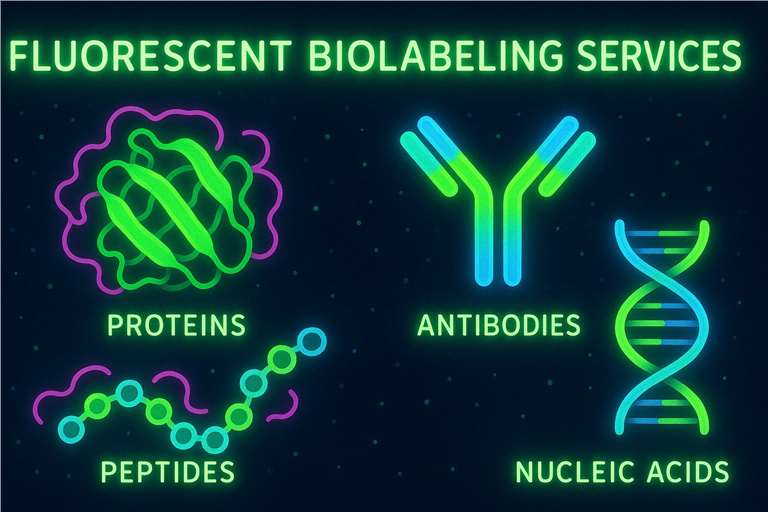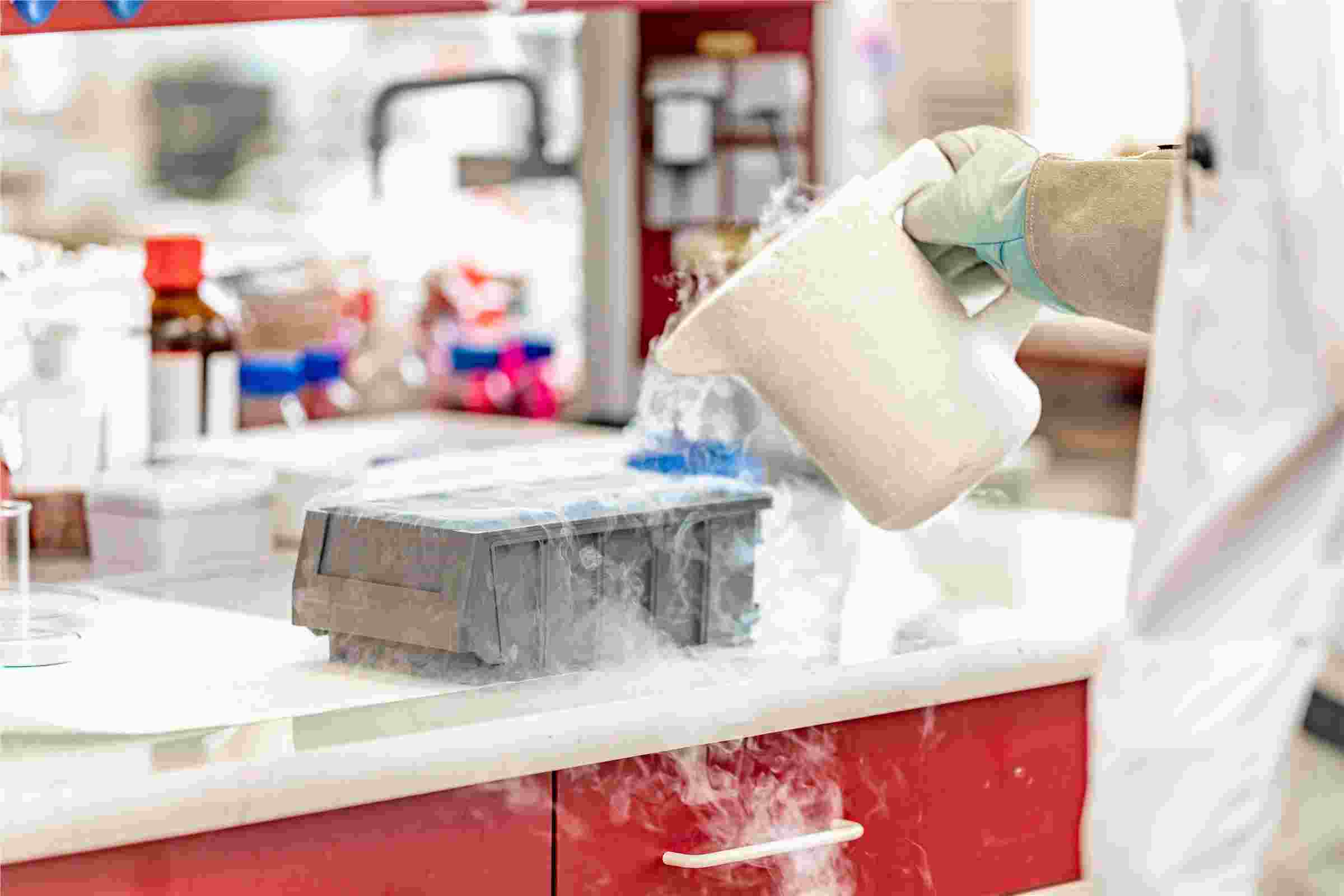Bioconjugation
BOC Sciences has established a comprehensive fluorescent dye conjugation chemistry platform, focusing on providing efficient and precise biolabeling solutions for life sciences and drug development. We possess the capability to customize a wide range of fluorophores, from classical dyes to near-infrared probes and FRET pairs, and have mastered multiple efficient conjugation strategies to ensure conjugation efficiency and specificity to target molecules. The platform encompasses NHS ester–amine reactions (widely used for protein and nucleic acid labeling), maleimide–thiol reactions (suitable for cysteine site modification), azide–alkyne click chemistry (for bioorthogonal labeling under complex conditions), as well as traditional dye labeling reactions such as succinimidyl esters and isothiocyanates. Through a rigorous quality control system—including HPLC, MS, and UV-Vis analysis—we ensure each fluorescent dye product demonstrates excellent performance in conjugation efficiency, photostability, and signal-to-noise ratio, fully empowering applications such as flow cytometry, immunoassays, in vivo imaging, and drug screening.

Comprehensive Capabilities of BOC Sciences in Fluorescence Field
Customized Products
BOC Sciences provides various fluorescent dye customization services, covering traditional dyes, near-infrared dyes, FRET pairs, and photosensitive probes, meeting diverse research and industrial needs regarding spectral properties, reactive groups, and functional structures.Specialized Conjugation
Equipped with advanced chemical modification and conjugation technologies, we achieve stable, directional, and efficient covalent linkage between fluorescent dyes and target molecules such as proteins, antibodies, peptides, nucleic acids, and small molecules, ensuring labeling efficiency and biological activity.Diverse Applications
Our products and services extensively support immunoassays, flow cytometry, molecular imaging, real-time quantitative PCR, drug screening, and FRET experiments, providing flexible solutions for life science research and pharmaceutical development.Controllable Quality
All fluorescent dyes are synthesized with high purity and undergo strict quality control via HPLC, mass spectrometry, and UV-Vis spectroscopy, ensuring photostability and reusability in complex experimental systems.
Fluorescent Solutions for Diverse Labeling Needs
BOC Sciences offers diversified fluorescent dye or probe solutions, specifically designed to meet various application needs such as biolabeling, imaging, and detection. Through precise chemical modification and bioconjugation strategies, we efficiently endow target molecules—such as proteins, nucleic acids, and small molecules—with stable and strong fluorescent signals, providing powerful technical support for life science research, drug development, and in vitro diagnostics.
Customized Fluorescent Dyes
BOC Sciences offers fluorescent dyes covering a broad wavelength range from the ultraviolet to the near-infrared region, satisfying multi-channel detection and multicolor imaging needs:
- Green fluorescent dyes
- Orange/red dyes
- Far-red/near-infrared dyes
- pH-sensitive dyes
- FRET pair dyes
Customized Fluorescent Probes
BOC Sciences offers integrated custom services from probe design to synthesis and validation, with a focus on the following types:
- Antibody-, peptide-, and oligonucleotide-dye targeting probes
- Ion probes for pH, Ca²⁺, Mg²⁺, Zn²⁺
- Enzyme activity probes (e.g., esterase, protease substrates)
- ROS (reactive oxygen species) and RNS probes
- Dual-dye FRET pair design
Reactive Group Modification
BOC Sciences can provide fluorescent dyes with specific reactive groups according to customer needs, ensuring compatibility with different types of biomolecules:
- NHS esters: covalently conjugated with amines in proteins or antibodies
- Maleimides: selectively react with cysteine thiol groups
- Azide/alkyne: used for fast labeling via click chemistry
- Biotinylated dyes: indirect labeling via streptavidin systems
Bioconjugation Platform: Efficient Conjugation of Biomolecules
BOC Sciences has built a complete, advanced, and flexible bioconjugation platform, dedicated to the efficient and stable conjugation of fluorescent dyes to target biomolecules. While maintaining the bioactivity of the molecules, we ensure excellent fluorescent performance, significantly enhancing the sensitivity and reliability of downstream experiments.
Protein and Antibody
LabelingFor antibodies (IgG), enzymes (such as HRP and AP), and modified proteins (such as streptavidin), BOC Sciences uses NHS ester, maleimide, and click chemistry strategies to efficiently label amino, thiol, and glycosylation sites. With optimized conjugation conditions, we effectively avoid crosslinking or protein denaturation.
Nucleic Acid
LabelingWe provide 5' end, 3' end, and internal labeling options, supporting the construction of oligonucleotides with single, dual, or multiple labels. Applications include fluorescence in situ hybridization (FISH), qPCR probes (e.g., TaqMan probes, molecular beacons), and the development of nano-scale nucleic acid probes. BOC Sciences also offers customized synthesis and purification services for fluorescently labeled oligonucleotides, ensuring high purity and accuracy.
Small Molecule and
Peptide LabelingFor structurally complex yet low-molecular-weight compounds such as small-molecule inhibitors, sugars, lipids, and cyclic peptides, we adopt targeted functional group activation strategies (e.g., carboxyl activation, thiol protection-deprotection systems) to achieve directional conjugation. We verify product uniformity and functionality using methods such as HPLC.
Drug Delivery
System LabelingBOC Sciences also possesses expertise in fluorescent labeling for various drug carriers, including antibody-drug conjugates (ADCs), liposomes, polymeric micelles, and nanoparticles. These are used to study drug release behavior, targeting efficiency, and pharmacokinetics. Common strategies include PEG-dye modification, lipid-dye insertion, and fluorescence introduction at polymer chain ends.
Complete Conjugation Process and Quality Control System
BOC Sciences offers one-stop fluorescent dye bioconjugation services. We provide conjugation services ranging from small to medium quantities for experimental projects, and we also possess an industrial-scale production platform capable of batch conjugation from milligrams to grams, meeting the scale-up needs of downstream diagnostic kits, commercial antibody products, or drug screening tools. Our key service processes include:
- Molecular Design and Site Selection: Selecting suitable dye types and reactive groups based on customer requirements;
- Chemical Synthesis and Conjugation Reaction: Conducting efficient and specific labeling reactions under controlled conditions;
- Purification and Impurity Removal: Removing free dyes and by-products through gel filtration, dialysis, HPLC, or ultrafiltration;
- Analysis and Characterization: Confirming conjugation efficiency, labeling ratio, purity, and functional activity using UV-Vis spectroscopy, fluorescence spectroscopy, mass spectrometry, SDS-PAGE, FPLC, etc.;
- Final Delivery and Technical Support: Providing a complete quality control report and user instructions to support customers' subsequent applications.
Quality Control System
- UV-Vis Spectrophotometer
- Fluorescence Spectrophotometer
- High-Performance Liquid Chromatography (HPLC)
- Liquid Chromatography-Mass Spectrometry (LC-MS)
- Mass Spectrometer (MS)
- Fourier Transform Infrared Spectrometer (FTIR)
- Nuclear Magnetic Resonance Spectrometer (NMR)
- Dynamic Light Scattering Analyzer (DLS)
- Size Exclusion Chromatography (SEC)
- Capillary Electrophoresis (CE)
- Flow Cytometer
- Confocal Laser Scanning Microscope (CLSM)
Applications of Fluorescent Biolabeling
Fluorescent dyes, as precise and sensitive molecular probes, are widely used in biolabeling and detection technologies, driving advances in modern life sciences, drug development, and clinical diagnostics. By conjugating with antibodies, proteins, nucleic acids, or nanomaterials, fluorescent dyes can be applied in visual analysis, targeted tracking, dynamic monitoring, and high-throughput screening, empowering cutting-edge biological research and medical practices.

Drug Development
By labeling fluorescent probes onto small-molecule drugs, antibodies, or carrier systems, researchers can track drug distribution and target interaction in cells or animal models, enabling high-throughput pharmacodynamic screening, receptor binding analysis, and in vivo pharmacokinetic evaluation, significantly enhancing the efficiency and reliability of new drug development.
Drug Delivery
Fluorescent dyes are widely used for visual labeling of drug delivery systems and can be conjugated with drug carriers such as antibodies, nanoparticles, and liposomes to monitor their distribution and targeting ability in real time. Especially in the development of antibody-drug conjugates (ADCs) and smart nanomedicines, fluorescent labeling is a key tool for pharmacokinetic research, targeting efficiency validation, and tumor localization imaging, essential for evaluating efficacy and safety.
High-Throughput Screening
Fluorescent dyes play a central role in chip platforms and are widely used in high-throughput screening processes for protein chips, nucleic acid chips, and cell chips. By precisely labeling specific target molecules in samples, researchers can quickly screen thousands of interaction relationships, protein expression patterns, or mutation sites, enabling automated data acquisition and multidimensional information analysis, greatly improving the efficiency of bioinformatics and precision medicine research.
In Vivo Imaging and Animal Studies
Near-infrared fluorescent dyes possess high tissue penetration and low background interference, making them ideal for in vivo imaging experiments in small animal models. By conjugating fluorescent probes with biomacromolecules or drug delivery systems, it is possible to achieve real-time localization and dynamic monitoring of tumors, inflammation, and metabolically active regions, providing intuitive and reliable data support for new drug screening, target validation, and disease mechanism research.
Cellular and Tissue Imaging
By labeling target molecules in cell or tissue samples with fluorescent dyes, researchers can localize molecules within cells, observe dynamic distributions, and perform multi-label co-staining imaging. Common applications include visual labeling of cellular organelles such as mitochondria, endoplasmic reticulum, and lysosomes, as well as co-localization analysis of specific proteins using fluorescent antibodies or multicolor probes, broadly serving fields such as cell biology, neuroscience, and developmental research.
FAQs About Fluorescent Bioconjugation
Can special structures of fluorescent dyes be customized?
Yes. We support customized dye structures, functional group types (e.g., NHS, maleimide, azide, etc.), and wavelength characteristics to meet labeling requirements for different experimental systems.
What types of molecules can fluorescent dyes be conjugated to?
Our dyes can be efficiently conjugated to proteins, antibodies, peptides, nucleic acids, small-molecule drugs, nanoparticles, and other biomolecules, suitable for a wide range of biolabeling applications.
Do you provide conjugated dye-biomolecule complexes?
Yes. We can provide complete dye-protein/antibody/nucleic acid conjugation services, delivering purified and stable complexes for immediate downstream use.
How is the quality of fluorescent dyes verified?
All products undergo rigorous quality control using multiple analytical techniques such as HPLC, mass spectrometry (MS), UV-Vis absorption, and fluorescence emission spectroscopy to ensure purity, stability, and optical performance.
Are fluorescent dyes suitable for in vivo experiments?
Do you support global shipping and fast delivery?
Yes. We support global distribution. Stock is available for standard products, and customized projects can be delivered within a short lead time. We also offer comprehensive cold-chain logistics solutions to ensure product quality.
Online Inquiry

